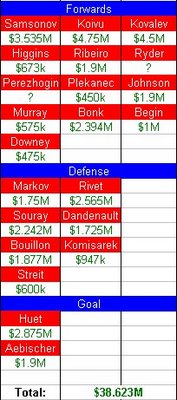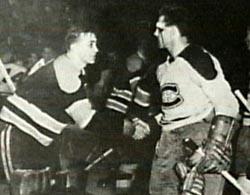Mission Accomplished
Next acquisition: Mike Johnson from Phoenix for a 4th round
 pick. This looks like a replacement for Bulis.
pick. This looks like a replacement for Bulis.Speaking of Bulis, I can't help thinking this guy got a raw deal. He's an above-average checking-line player and he was happy with that role. He's got OK size, lots of speed, and was a solid plus player. Maybe Gainey has some off-ice justification for letting him go. By all appearances, one of the other 29 teams is going to be getting good cost-effective icetime out of him.
As for Johnson, I haven't seen much of him since his days with the Leafs. He appears to be an OK two-way forward.
Other signings:
Mike Ribeiro, one year at $1.9M. Unreal. I was hoping to see 30-goal man Ryder signed for that amount. I guess I'm out of touch with reality, like some little old lady on The Price Is Right who thinks new Cadillacs still cost about $6000. Ribs said he didn't want to risk a paycut by going to arbitration. Which begs the question, Why the H-E-double-hockey-sticks didn't Gainey take HIM to arbitration? How is Saku's eye, anyway?
Mikhail Grabovsky, two-year two-way deal. Finally!
J-P Cote, one year two-way. Cote's skating appears to be a disturbing, unnatural act, like biting your elbow. Body parts just aren't supposed to move like that. Eyesore or not, he filled in admirably when the Habs' blueline was severely depleted.
Mathieu Aubin and Matt d'Agostini: filler for the Bulldogs.
Yet to be signed:
Michael Ryder. I figured $2M would be an upper limit for him until the Ribeiro deal. There haven't been many comparable RFA deals this summer. Some previous RFA salaries were Parrish at $1.9M, Sturm at $2.1, Comrie at $1.75, and maybe Calder at $1.3M. $2M seems like a lot for a guy who doesn't skate well and only gets all the plum PP minutes because no one else on the team can finish.
Alexander Perezhogin. It will be less than $1M. Just a matter of time.
Here's a salary chart. It's annoyingly grainy unless you click on it, and I'm not going to fix it because I'm lazy:

There appears to be one unresolved issue: Aebischer.
What's best for the team? The pairing of Huet/Aeby at just under $5M? Or Huet/Danis and the sack of peanuts Aeby fetches in a trade for just under $3.5M?
Dan Cloutier was worth a mid-2nd round pick. That suggests there isn't much of a market out there for Aebischer right now. Plus, the $1.9M in cap space is pretty much irrelevant for the Habs since they won't be spending close to the limit. It's probably wise to wait and see who needs goaltending mid-season then reconsider.
~~~
"Even places like Montreal. You'd say to yourself wow, that's the birthplace of real hockey, and you'd think they'd want all that mystique that goes with Montreal. But I've had players say 'I don't want to go there, hell it's cold up there.' "
Oh well. That's free agency for you.
~~~
To further beat a dead horse, here's a table comparing some high-risk/high-reward defensemen to some low-risk/low-reward types with comparable +/- and even-strength minutes:
Looking only at their even-strength differential (per 60 minutes or per game) Chelios and Preissing are very close, as are Blake and Regehr. I included Blake and Preissing with an extra plus, just to bring the numbers closer to (or better than, in Preissing's case) their comparisons.
Looking at the 'Pythagorized' +/- (which will be the same, whether you judge per 60 or per game), all four are better than .500. Chelios beats Preissing and Regehr beats Blake.
I'm not saying which players are better than others - not even when judging by EV+/- alone. That's impossible to gauge without including teammates/opposition (Chelios and Regehr are on better teams, but I think they also face better forwards than the other two). It's merely an illustration of how a linear/differential-based evaluation will differ from a ratio/Pythagorean-based evaluation.
Update: I just did some calculations on what Blake and Preissing would have to do to bring their pyth. goal differential up to the levels of Regehr and Chelios.
Given the same number of minuses, Preissing would have to bring his plusses up by 10 for a net differential of +29 in order to reach Chelios' 0.72. Blake would have to gain an additional 7 plusses for a net of +12 to reach Regehr's 0.58.
That's a bizarre thing to wrap your head around. For Blake to be as effective as Regehr's +5 (+32/-27) at even strength, he has to produce a +12 (+77/-65). For Preissing to be as effective as Chelios' +19 (+50/-31), he has to produce +29 (+77/-48). Those are big differences.
Update 2: Thinking even more about ratio vs. differential, it would seem that it's better to be a gambler than a stay-at-home type if your differential is sub-zero.
For precisely the same reason that +10/-5 is better than +20/-15, putting up +15/-20 is better than +5/-10. If a team scores 10 and allows 20, they will not have as good a record as a team that scores 30 and allows 40 over the same number of games.
A stay-at-home +5 is better than a risk-taker's +5, but a stay-at-home -5 is worse than a risk-taker's -5. Weird.


3 Comments:
RE: +/-
You can furthur expand this to include PP and PK winning %'s (must assume x goals against and minuses). This data is basically as useful as player contribution to predict salaries (good sign...) (PP and PK account for ~1/3 of goals).
Problem is, you dont attribute defense to defenseman and offense to forwards (a player can look good by playing with the right players): This is the beauty of player contribution. Although one could expand this concept to attempt to do this (maybe I'll do that later).
Sounds ambitious.
I've been wasting far too much time at your website lately. I have a question for you: Why are the EV+/EV- figures represented as percentages?
I originally used them for PP and PK and wanted a value that could be compared to the team PK/PP %'s, I've changed the multiplier to get a more range within 0-100.
I'll probabaly change them to GAA though as that would make more sense for most people.
Post a Comment
<< Home